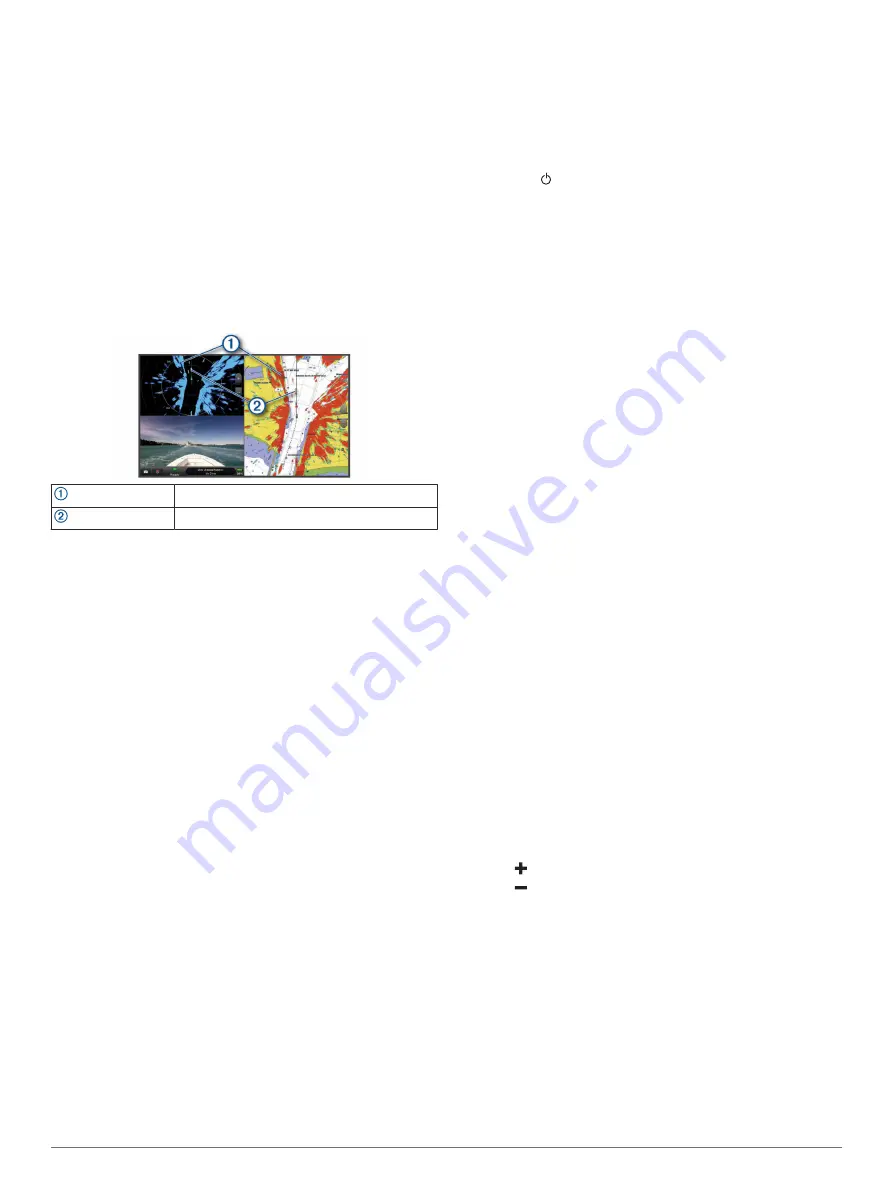
Radar Interpretation
Reading and interpreting the radar display takes practice. The
more you use the radar, the better you will become at relying on
the radar display when you really need it.
Radar can be useful in many situations, such as avoiding
collisions when you have limited visibility, for example when it is
dark or foggy, tracking weather, seeing what is ahead of you,
and locating birds and fish.
The radar overlay feature can help you interpret the radar
display more easily, because it overlays the radar returns on top
of the chart. This can help you identify the difference between a
radar return of a land mass, bridge, or rain cloud. Showing the
AIS vessels on the radar overlay can also help you identify
features on the radar display.
In the screenshot below, the radar overlay is turned on. This
screen also shows a video feed. We can easily identify a few
items on the radar screen.
Land
Vessel
Radar Overlay
When you connect your chartplotter to an optional Garmin
marine radar, you can use overlay radar information on the
Navigation chart or on the Fishing chart.
Data appears on the radar overlay based on the most recently
used radar mode and all settings configurations applied to the
radar overlay are also applied to the last-used radar mode.
Radar Overlay and Chart Data Alignment
When using the Radar overlay, the chartplotter aligns radar data
with chart data based on the boat heading, which is based by
default on data from a magnetic heading sensor connected
using a NMEA 0183 or NMEA 2000 network. If a heading sensor
is not available, the boat heading is based on GPS tracking
data.
GPS tracking data indicates the direction in which the boat is
moving, not the direction in which the boat is pointing. If the boat
is drifting backward or sideways due to a current or wind, the
Radar overlay may not perfectly align with the chart data. This
situation should be avoided by using boat-heading data from an
electronic compass.
If the boat heading is based on data from a magnetic heading
sensor or an automatic pilot, the heading data could be
compromised due to incorrect setup, mechanical malfunction,
magnetic interference, or other factors. If the heading data is
compromised, the Radar overlay may not align perfectly with the
chart data.
Transmitting Radar Signals
NOTE:
As a safety feature, the radar enters standby mode after
it warms up. This gives you an opportunity to verify the area
around the radar is clear before beginning radar transmission.
1
With the chartplotter off, connect your radar as described in
the radar installation instructions.
2
Turn on the chartplotter.
If necessary, the radar warms up and a countdown alerts you
when the radar is ready.
3
Select
Radar
.
4
Select a radar mode.
A countdown message appears while the radar is starting up.
5
Select
Menu
>
Transmit Radar
.
Stopping the Transmission of Radar Signals
From a radar screen, select
Menu
>
Radar To Standby
.
TIP:
Press >
Radar To Standby
from any screen to
quickly stop radar transmission.
Setting Up the Timed Transmit Mode
To help conserve power, you can set up time intervals in which
the radar will transmit and not transmit (standby) signal
transmissions.
NOTE:
This feature is not available in dual radar modes.
1
From a radar screen, select
Menu
>
Radar Options
>
Timed
Transmit
.
2
Select
Timed Transmit
to enable the option.
3
Select
Stdby Time
, enter the time interval between radar
signal transmissions, and select
Done
.
4
Select
Transmit Time
, enter the duration of each radar
signal transmission, and select
Done
.
Enabling and Adjusting a Radar No Transmit Zone
You can indicate areas within which the radar scanner does not
transmit signals.
NOTE:
GMR Fantom and xHD2 radar models support two no-
transmit zones. Other GMR radar models support one no-
transmit zone.
1
From a radar screen, select
Menu
>
Radar Setup
>
Installation
>
No Transmit Zone
.
The no-transmit zone is indicated by a shaded area on the
radar screen.
2
Select
Angle 1
, and select the new location for the first
angle.
3
Select
Angle 2
, and select the new location for the second
angle.
4
Select
Done
.
5
If necessary, repeat for the second zone.
Adjusting the Radar Range
The range of the radar signal indicates the length of the pulsed
signal transmitted and received by the radar. As the range
increases, the radar transmits longer pulses in order to reach
distant targets. Closer targets, especially rain and waves, also
reflect the longer pulses, which can add noise to the Radar
screen. Viewing information about longer-range targets can also
decrease the amount of space available on the Radar screen for
viewing information about shorter-range targets.
• Select to decrease the range.
• Select to increase the range.
Tips for Selecting a Radar Range
• Determine what information you need to see on the Radar
screen.
For example, do you need information about nearby weather
conditions or targets and traffic, or are you more concerned
about distant weather conditions?
• Assess the environmental conditions where the radar is being
used.
Especially in inclement weather, longer-range radar signals
can increase the clutter on the Radar screen and make it
more difficult to view information about shorter-range targets.
In rain, shorter-range radar signals can enable you to view
information about nearby objects more effectively, if the rain
clutter setting is configured optimally.
32
Radar
Содержание GPSMAP A12
Страница 1: ...GPSMAP A12 Owner sManual...
Страница 8: ......
Страница 73: ......
Страница 74: ...support garmin com December 2018 190 02262 00_0D...















































